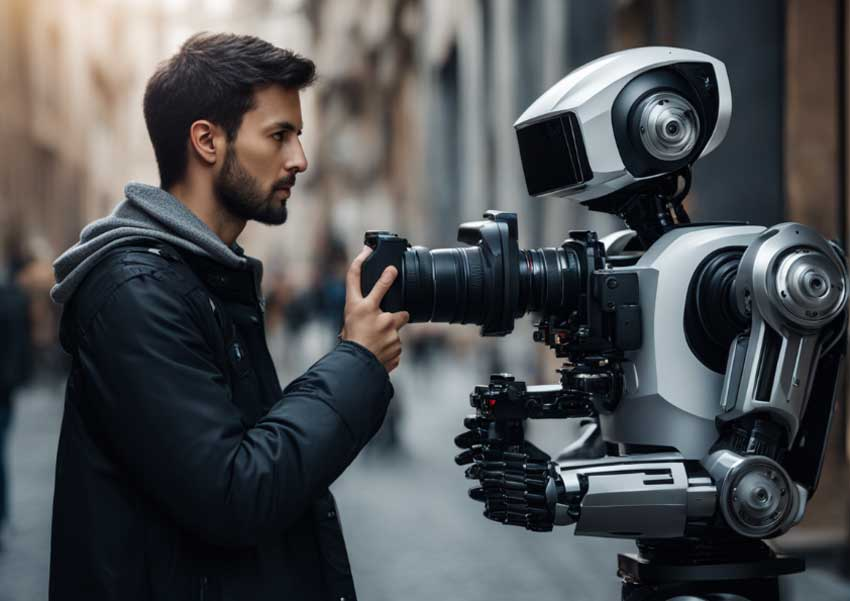
AI in Photojournalism: Preserving The Visual Record
AI in photojournalism is transforming the landscape of how visual stories are told and preserved. In an era where artificial intelligence photography is becoming increasingly sophisticated, it presents both threats and opportunities for the field. Notably, Kira Pollack, an Emmy award-winning visual storyteller, is at the forefront of exploring how AI can help safeguard photojournalism archives while preserving the true visual history of our times. By leveraging technology and photography, she aims to confront challenges such as copyright issues and the saturating presence of synthetic images that blur the line between fact and fiction. Pollack’s innovative approach to integrating AI tools could redefine how archives are maintained and accessed, ensuring that the legacies of groundbreaking photojournalists are not only preserved but also celebrated in an ever-evolving digital age.
The intersection of technology and visual storytelling is reshaping the future of photography, with artificial intelligence playing a pivotal role. Kira Pollack, a prominent figure in this discussion, highlights the urgent need to protect the historical significance of photojournalism while utilizing cutting-edge tools. This new wave of innovation is not just about documenting events; it’s about preserving visual narratives that are integral to our understanding of history. By addressing the challenges presented by the rapid advancement of generative AI, Pollack aims to explore solutions that maintain the integrity of photographic storytelling. The journey to recalibrate the relationship between emerging technology and the rich repositories of photojournalistic archives is both critical and timely.
The Role of AI in Photojournalism Preservation
In today’s rapidly evolving digital landscape, the role of AI in photojournalism is becoming increasingly pivotal. Kira Pollack, a notable visual storyteller and Emmy award-winning journalist, is at the forefront of this movement. She emphasizes that while AI seems to threaten the fabric of traditional photojournalism through issues like copyright infringement and the proliferation of misleading synthetic images, it also holds the key to preserving the invaluable visual history captured in photojournalism archives. By innovatively applying AI, Pollack believes photojournalists can safeguard their extensive collections, ensuring these important visual narratives are not lost to time or technological upheaval.
The integration of AI technology offers promising avenues for the curation and preservation of photographic archives, allowing for more robust management of vast bodies of work that often go unseen. AI can assist in cataloging these images, providing context that enhances their significance. Pollack’s initiatives revolve around leveraging AI to maintain the integrity of this historical record while also making it accessible to future generations, thus preserving visual history in a way that respects the original photographs’ authorship.
Preserving Visual History Through Advanced Technology
Preservation of visual history is a pressing concern in the field of photojournalism, especially as the landscape becomes increasingly populated by artificial intelligence and digital technologies. Pollack’s work underscores that photo archives are not merely static historical records, but dynamic narratives that reflect society’s collective memory. By employing modern technologies, photojournalists can enhance the searchability and contextual relevance of their work, making the visual history they represent more available and relatable to contemporary audiences.
Moreover, Pollack’s focus on the archival work of war photographer Christopher Morris illustrates the critical need to maintain these records, particularly for significant historical events. Engaging AI to interpret complex narratives within these photographs not only protects the past but also enriches present understanding. By mapping out emotional landscapes and intricate details of each image, AI can help to provide valuable insights that revive these archived stories, ensuring that visual history is both preserved and appreciated.
Kira Pollack’s Vision for the Future of Photojournalism
Kira Pollack’s vision extends beyond merely preserving photographic archives; she aspires to redefine how photojournalism interacts with the evolving technological environment. Her approach advocates for a harmonious balance between leveraging AI to enhance visual storytelling and maintaining the ethical standards that underpin photojournalism. Through her fellowship at the Shorenstein Center, she aims to foster dialogues that bridge the gap between technologists and journalists, emphasizing a collaborative approach to the challenges posed by AI.
The essential question remains: how do we harness AI to serve the core values of photography — truth, authorship, and memory? Pollack seeks to engage thoroughly with these queries, aiming to ensure that as photojournalism adapts to new technologies, it does so without compromising its foundational principles. Her work champions the potential for AI to not only archive and protect photojournalism’s past but also to illuminate its path forward in a landscape increasingly dominated by digital influence.
Challenges of AI in Photojournalism
While the potential of AI in photojournalism is significant, it is accompanied by challenges that professionals in the field must reckon with. One of the most pressing issues is the risk of copyright infringement, where AI algorithms could scrape photographers’ works without permission for training models. This concern not only threatens the livelihoods of photojournalists but also raises fundamental questions about ownership and authorship in the digital age. Pollack’s insights highlight the urgency of developing frameworks that protect artists’ rights while navigating the complexities of technological integration.
Additionally, the erosion of trust in visual media brought on by AI-generated imagery complicates the landscape for genuine photojournalism. In an era where authenticity is paramount, the proliferation of synthetic images can undermine the credibility of real photos captured in significant moments. Pollack’s research aims to address these issues by creating systems that differentiate and authenticate real images, reinforcing the trustworthiness of photojournalism amidst technological advancements.
Ethics of Using AI in Photographic Contexts
The introduction of AI into photojournalism underscores a critical examination of ethical practices surrounding its use. As Pollack navigates through this realm, her focus expands to the implications that technological tools have on the integrity of photographic work. There’s a crucial need to consider how AI can be ethically applied without compromising the photographer’s rights or the original intent of their images. This involves thoughtful engagement with AI systems, ensuring that they are designed to support rather than manipulate the narratives depicted in photographs.
Engaging ethical stakeholders in the conversation, Pollack aims to chart a course where technology gets aligned not just with productivity, but with the values that undergird the journalism profession. By advocating for responsible AI applications, she envisions a future where these technologies enhance the storytelling potential of photojournalism without overshadowing its commitment to truth and authentic representation.
AI as a Tool for Storytelling in Photojournalism
Artificial intelligence possesses the transformative power to enhance storytelling in photojournalism by uncovering deeper insights within visual content. In collaboration with photojournalist Christopher Morris, Pollack is exploring how AI can analyze complex narratives in photographs, extracting contextual details that resonate with viewers and elevate the storytelling process. The capacity for AI to interpret emotional undertones and visual symbolism offers new dimensions to how stories are presented, enabling photojournalists to engage audiences in more compelling ways.
This storytelling enhancement is pivotal, particularly in a time when photojournalism faces fierce competition for attention in digital narratives. By utilizing AI to weave intricate layers of meaning into their work, photojournalists can ensure their stories not only capture moments but also evoke emotional responses and critical reflections from their audiences, thereby reinforcing the artistry and power of visual storytelling.
Future Outlook: AI and the Evolving Landscape of Photojournalism
As we look to the future of photojournalism, the interplay between AI technology and its evolving role within the field presents both unprecedented opportunities and significant challenges. Pollack’s research indicates that while AI can facilitate the preservation and access of photojournalism archives, it is imperative to tread carefully regarding its implications for authenticity and trust. The ongoing dialogue amongst professionals and technologists will shape the trajectory of this relationship, guiding practices that prioritize ethical considerations and uphold the core values of photojournalism.
The engagement with such technology is not just about adaptation; it is about reimagining the vision of visual journalism in a digitally dominated landscape. By integrating AI thoughtfully, photojournalists like Pollack aim to cultivate an environment where technological advancements enhance, rather than replace, the artistry and truth inherent in photography. This forward-thinking approach promises to lead to innovative practices that uphold and elevate the integrity of photojournalism for future generations.
The Importance of Photojournalism Archives
Photojournalism archives hold an immense wealth of visual history, yet their significance often goes unrecognized. Pollack’s insights illuminate the necessity of safeguarding these archives, not merely as collections of images but as vital records of human experience and social events. Given that a remarkable portion of these photographs never sees the light of day, it is essential to develop methods for their preservation and organization. Through AI, photojournalism can find innovative ways to make these archives accessible and relevant, allowing them to inform and educate future generations.
Moreover, as we navigate an era marked by rapid technological change, the importance of these archives grows ever greater. They provide a foundation for understanding the past, fostering cultural memory, and informing the present. By utilizing technology to unlock these narratives, photojournalists can ensure these historical documents remain integral to society’s collective memory.
Navigating the Intersection of Technology and Authenticity
In the forthcoming era of photojournalism, the intersection of technology and authenticity is a critical focal point of discussion. As AI and other tech-driven tools become commonplace in the industry, professionals like Pollack are tasked with reconciling the benefits of innovation with the necessity for genuine representation. A core challenge lies in distinguishing real photographs from artificially generated images, particularly in a media landscape where misinformation can spread rapidly.
Pollack’s exploration of ethical AI use reflects a commitment to preserving authenticity amidst technological advancement. The framework being developed aims to prioritize accuracy while leveraging AI’s capabilities to assist rather than compromise journalistic integrity. By navigating these complexities, the photojournalism community can safeguard the authenticity of visual narratives and maintain the trust of the audiences they serve.
Frequently Asked Questions
How can AI technology impact photojournalism archives?
AI technology offers innovative solutions for managing photojournalism archives by analyzing, organizing, and categorizing vast collections of visual records. With AI, photojournalists can efficiently preserve their rich archives and make them more accessible, ensuring that significant historical events documented through photography remain visible and impactful.
What role does Kira Pollack play in the intersection of AI and photojournalism?
Kira Pollack, an Emmy award-winning visual storyteller and the Walter Shorenstein Media & Democracy Fellow, is researching how AI can protect and preserve the visual history documented by photojournalists. By utilizing AI tools, she aims to organize and contextualize photojournalism archives effectively, ensuring that the integrity and authenticity of the images are upheld.
What are the risks associated with AI in photojournalism?
The primary risks of AI in photojournalism include the potential for copyright violations and the creation of synthetic images that could blur the line between reality and fiction. This erosion of trust can undermine the credibility of photojournalism, making it essential to harness AI responsibly while preserving the authenticity and factual accuracy of visual storytelling.
Can AI help in preserving the visual history of photojournalism?
Yes, AI has the potential to preserve visual history by efficiently cataloging and analyzing photojournalism archives. By utilizing AI, photographers can ensure that crucial images from past events are organized and discoverable, protecting the legacy of their work and the historical narratives they represent.
How does Kira Pollack envision the use of AI in understanding complex imagery in photojournalism?
Kira Pollack envisions AI as a tool that can interpret complex imagery in photojournalism. Her research includes analyzing photos from significant historical events, testing AI’s ability to understand nuanced contexts and emotions in these images, ultimately aiming for AI to assist in preserving important visual narratives.
What are the ethical considerations when using AI in photojournalism?
Ethical considerations include ensuring that AI is not used to generate misleading images but rather to enhance the preservation and understanding of real photojournalism. It is critical to safeguard photographers’ rights, ownership, and intent while leveraging AI technology to responsibly catalog and surface their work.
How might AI change the narrative structure in photojournalism archives?
AI could revolutionize narrative structures in photojournalism archives by providing immersive and dynamic storytelling frameworks. By identifying themes and contextual layers in images, AI can help highlight the photographer’s intent, allowing viewers to engage more deeply with the historical context of the imagery.
What is the future of photojournalism with AI technology?
The future of photojournalism with AI technology involves a cautiously optimistic integration where AI facilitates the preservation, organization, and contextualization of visual history, while also addressing challenges such as copyright and trust. By leveraging AI, the photojournalism community can enhance the impact of their work while maintaining authenticity and ethical standards.
| Aspect | Key Points |
|---|---|
| Threats to Photojournalism | AI poses risks through copyright issues and the creation of fake images, potentially undermining public trust. |
| Kira Pollack’s Perspective | Pollack believes AI could be used constructively to preserve invaluable archives of photojournalism. |
| Research Focus | Investigating AI’s potential to catalog, organize, and contextualize the work of photographers. |
| Example of AI Application | AI has successfully analyzed complex images from conflict zones, demonstrating its ability to interpret nuance. |
| Concerns Over Trust | While AI can help in organizing archives, there are fears about its role in creating misleading images. |
| Goals of the Fellowship | Engage in dialogues about the implications of technology on journalism and photography. |
Summary
AI in photojournalism presents both challenges and opportunities as it reshapes the landscape of visual storytelling. While the rise of artificial intelligence raises concerns about copyright infringement and the authenticity of images, it also offers innovative solutions for preserving the vital archives of photojournalists. Kira Pollack’s endeavors illustrate the dual nature of AI: it can enhance our understanding and organization of photographic work while prompting critical discussions about integrity and trust in journalism. As we navigate these complex issues, leveraging AI responsibly may help safeguard the future of photojournalism, ensuring that the visual history of our world remains accessible and authentic.


